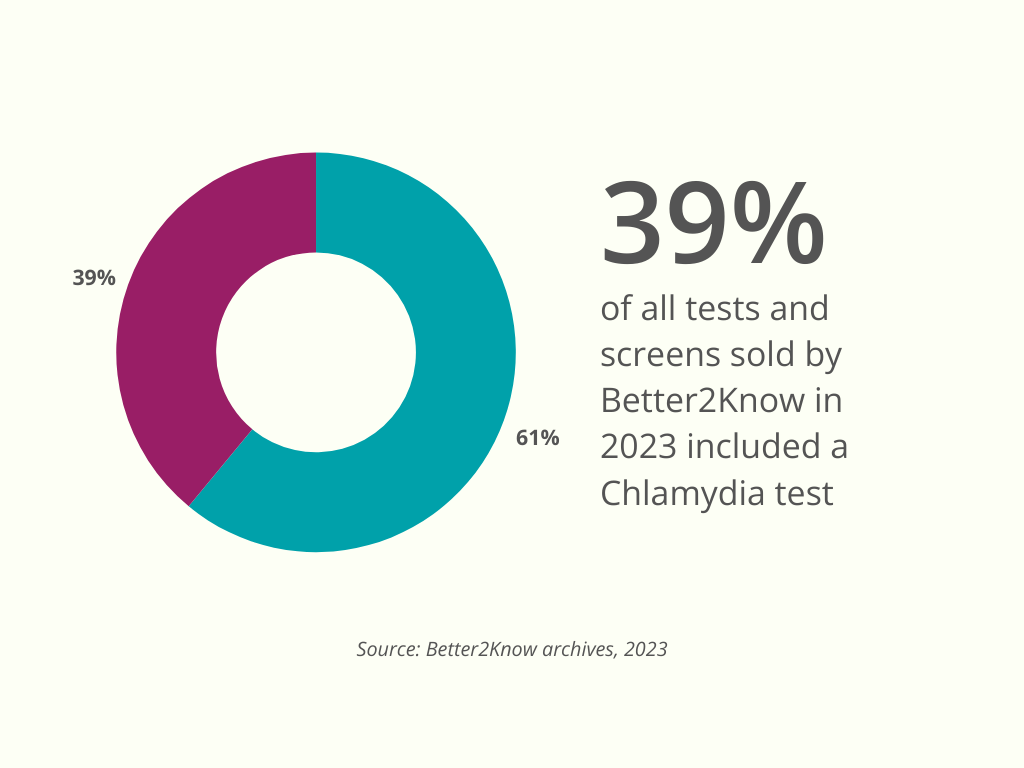As one of the most common sexually transmitted infections (STIs) worldwide, Chlamydia affects tens of thousands of Australians each year.
Despite its prevalence, it often goes unnoticed due to its potential to present with no symptoms, leading to serious complications if left untreated.
Understanding the symptoms of Chlamydia, and more importantly, how they can come and go during an infection, is key to preventing its spread and ensuring timely treatment.
This blog aims to shed light on the nature of Chlamydia’s symptoms, how they can fluctuate during an infection, and why it’s essential not to ignore them.
Let’s get started!
Understanding Chlamydia - what is it and how can you get it?
Chlamydia is an STI caused by the bacterium Chlamydia trachomatis. It has an uncanny ability to go undetected in people who have it, which often results in it being passed on without the knowledge of the carrier.
The infection spreads through unprotected sex or sexual contact with someone who has the infection. This includes vaginal, anal, and oral sex. There is also a risk of passing on the infection by sharing sex toys.
The infection can also be passed from an infected mother to her baby during childbirth. This method of transmission can often have negative health results for the infant.
Despite many myths about the infection, you can’t get it from:
- Kissing
- Holding hands
- Sharing cutlery
- Sharing clothes or towels
- A toilet
- Inhaling droplets from someone who coughs or sneezes
What are the risk factors for getting Chlamydia?
Now, let’s talk about risk factors.
Anyone who is sexually active can get Chlamydia, but factors that may increase your risk of Chlamydia include:
- Being sexually active at a young age: Chlamydia is most common in people aged 15-24.
- Having multiple sexual partners: The more partners you have, the greater your risk of exposure.
- Not using condoms consistently: Condoms, when used correctly, can provide protection against Chlamydia.
- Having a history of STIs: If you’ve had an STI in the past, you’re statistically more likely to get another one.
How many people have Chlamydia in Australia?
Chlamydia is very common in Australia. According to the Kirby Institute, around 81, 000 people were diagnosed with Chlamydia in 2021. Of course, these were only cases that were diagnosed. Many more people are likely to have the infection and not know it.

Many of Better2Know’s customers seem to understand the prevalence of Chlamydia. In 2023, around 39% of all tests and screens sold by Better2Know included a test for Chlamydia.
What are the symptoms of Chlamydia?
When it comes to Chlamydia, symptoms can vary between men and women, and quite often, they may not appear at all. In fact, in both men and women, in genital, rectal, or throat infections, the majority of cases will be asymptomatic.
In men, symptoms may include:
- Discharge from the penis, typically in the morning
- Burning sensation during urination
- Increased need to urinate
- Testicular pain or swelling
Although symptoms in women are very uncommon, they may include:
- Abnormal vaginal discharge
- Burning sensation during urination
- Deep pain during intercourse
- Bleeding between periods or after sex
- Dull pain in the lower abdomen
- Increased need to urinate
These symptoms cover genital Chlamydia infections. Here are some symptoms you may experience if you get the infection in other parts of your body:
- Rectum: Chlamydia bacteria can infect the rectum. This usually happens through anal sex or sharing sex toys. You may experience rectal fullness, painful bowel movements and blood and/or mucous discharge from the anus.
- Throat: Chlamydia can also infect your throat. This usually happens if you perform unprotected oral sex on someone who has an active genital Chlamydia infection. The vast majority of these infections, close to 100%, will be asymptomatic.
Around 75% of women and 50% of men with Chlamydia don’t experience any genital symptoms at all. This lack of symptoms can lead to the infection being undiagnosed and untreated, which can cause serious health complications over time (more on that below). In the rectum, this percentage is as high as 90%, an din the throat almost 100%.
Do the symptoms of a Chlamydia infection come and go?
Chlamydia is a bit of a chameleon when it comes to its symptoms.
After exposure to the infection, symptoms can appear anywhere between one and three weeks. However, in some rare cases, it can take many months for symptoms to develop. Of course, some infections will have no symptoms.
This delayed onset can often lead to the false assumption that you’re not infected, thereby increasing the risk of unknowingly spreading the infection.
What’s more, the symptoms of Chlamydia have a tendency to come and go.
You might experience symptoms such as pain or discharge, which then disappear after a few days. This fluctuation can be misleading.
It’s important to understand that the disappearance of symptoms does not mean the infection is gone. The bacteria can still be in your system and can continue to cause damage if left untreated.
How do I get tested for Chlamydia?
Chlamydia is diagnosed through laboratory tests. These tests involve providing a urine sample. Urine samples are the most effective method for detecting the presence of the infection. However, in some cases a swab may be needed if there is an infection in the throat or rectum.
Regular screening is crucial, especially if you’re sexually active with multiple partners, have had Chlamydia before, or have other STIs. Regular screenings can help catch the infection early, even before symptoms appear, which is key to preventing complications.
How can I get treated for Chlamydia?
Treatment for Chlamydia is straightforward. It typically involves antibiotics, which can clear the infection. The course of your treatment will depend on the severity of your infection and an assessment of your overall health by a healthcare professional.
What happens if I don't get treated for Chlamydia?
Untreated Chlamydia can lead to all sorts of complications that can be detrimental to your health. Untreated Chlamydia can lead to:
- Increased infertility in both men and women
- Pelvic Inflammatory Disease (PID): A complication of several STIs where the fallopian tubes are scarred, making passage of the eggs from the ovaries to the womb more difficult. It can also cause chronic pain in the lower abdomen.
- Ectopic pregnancies: PID can cause ectopic pregnancies.
- Early birth: Chlamydia infections have been known to cause early births in women who are pregnant. It can also result in stillbirths.
- Complications during birth: If a woman has Chlamydia, the infant can become infected when they pass through the birth canal.
How can I avoid getting Chlamydia in the first place?
Despite ongoing work to develop a Chlamydia vaccine, preventing Chlamydia involves safe sex practices. This includes using condoms correctly every time you have sex, limiting the number of sexual partners, and getting regular screenings.
Use your best judgement about what sex practices you want to take part in in order to protect your health.
Final thoughts
Understanding Chlamydia, its symptoms, and how they can come and go is the first step in taking control of your sexual health.
At Better2Know, we’re here to help you every step of the way.
Don’t leave your sexual health to chance. Stay safe and get tested at a sexual health clinic near you.
This article has been medically reviewed by Dr. Steve Chapman, 29/07/2024.





